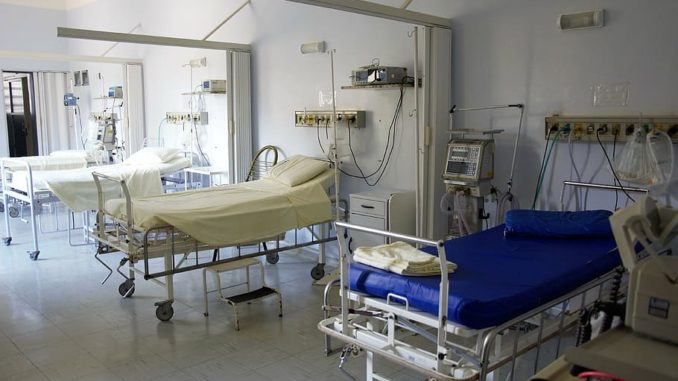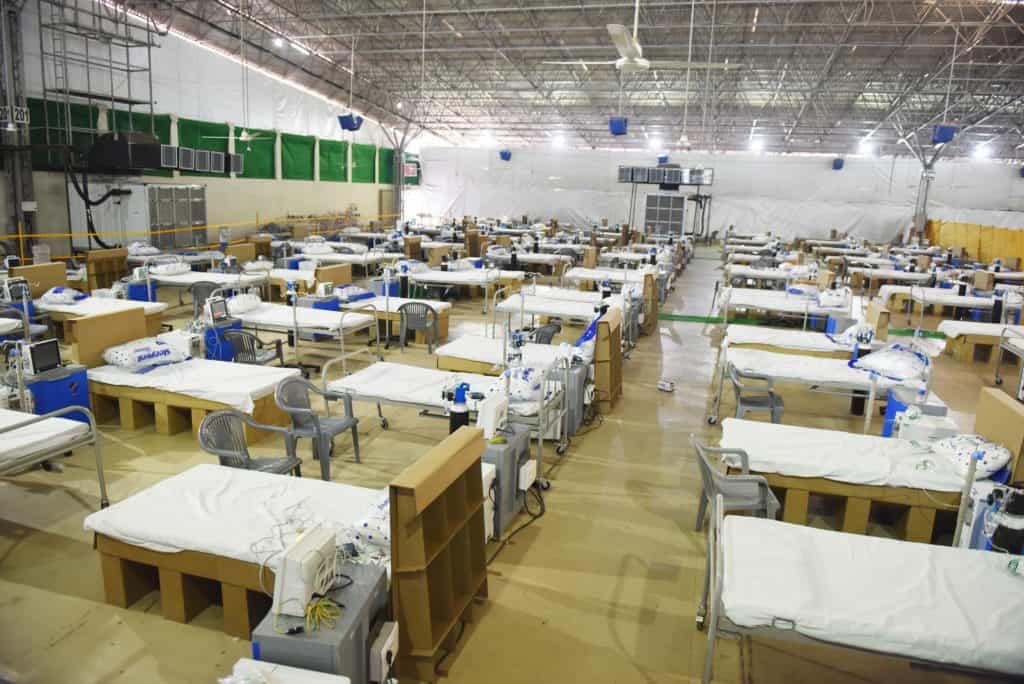The rapid spread of the COVID virus in India is worsening by the day. As is its management. Thousands are dying and lakhs are getting infected every day. Desperate cries for oxygen or a hospital bed from relatives and friends of COVID patients are flooding social media. Open the morning papers and what hits you are pictures of sick patients and their families gathering at the gates of hospitals.
It has become a literal ‘life and death’ struggle. For even after death, bodies have to wait for space at cremation and burial grounds.
This is definitely a war-like situation, where over four lakh people (officially) are being infected every day. While the actual number of daily deaths is most likely vastly more than the official figures.
The approach of both central and most state governments to this unprecedented health crisis is ‘not to break the inertia’ in the system, and to follow the ‘work as usual’ practice. This approach must be discarded and alternatives developed; if not from the top then from the bottom up.
Let us take, for example, two concrete instances of two cities, Delhi, a metropolis with a population of over 20 million, and Shimla, a small hill town of two lakh people.
A tale of two cities
Delhi boasts of its massive health infrastructure which crumbled badly in just a few days as uninterrupted supply of oxygen could not be maintained for patients. SOS calls by individuals and hospitals for oxygen and hospital bed has become a regular daily feature even a month after the second wave hit.
In Shimla, however, such a situation has not arisen yet. But going by the rise in numbers, the day is not too far when similar stories may be witnessed in this hill town as well. There is immense pressure on the medical fraternity, right from the sanitation staff to the doctors who have not taken any leave since March 2020. There is also the issue of people still getting infected, despite two shots of vaccine.
Read more: ‘How do I get my shot?’ and other FAQs on COVID vaccination Phase 3
But that is not the point. The point I am trying to make is that a complete revamp of the existing structure and operations must be done on a war footing. Just recently in a single ward of medicine unit in the Indira Gandhi Medical College and Hospital (IGMC) Shimla, 25 indoor patients tested positive for COVID. Likewise, in the intensive care unit of the Heart Centre, all the patients tested positive. All of them had tested negative in their RTPCR report while getting admitted to the hospital.
This is an alarming situation and is not limited to one hospital, but almost all the hospitals across the region. The virus is spreading fast and as stated it is a war-like situation where radical steps are urgently needed.
Vaccination, testing, treating, and isolation are the mainstay of managing this pandemic. Hence, it is critically important to ensure that adequate testing, isolation, and treatment facilities are created at the community level. This cannot be achieved by building new hospitals, as the time lag will be huge. The only way it can be achieved is by re-designating the already existing facilities in a time-bound manner. And changing the ‘work as usual’ mindset.
All hospitals and healthcare facilities need to be converted to COVID treatment facilities the moment the positivity rate crosses a particular threshold, which depends upon the disaster mitigation capabilities in a given situation. That is the only way out of the pandemic because multiple waves cannot be ruled out.
And this is what should be done.
Pool the resources
Let me cite two hospitals, Hindu Rao Hospital in Delhi and IGMC in Shimla. Hindu Rao is a 1,000-bed hospital run by the Delhi Municipal Corporation. However, only 832 beds are shown on the website. Out of these 832 beds, just 250 are allotted for COVID patients. The other 582 beds are kept aside for elective work which has now become redundant due to closure of outpatient department facilities.
Likewise, IGMC has 850 beds with 150 reserved for COVID patients. However, with some proactive interventions of the hospital administration, this hospital has 350 beds for COVID patients.
This is the situation with almost all large hospitals in the bigger cities, where only a small percentage of beds have been kept for COVID patients, with the rest of the hospital staff treating other patients. But as the virus is spreading super-fast, other departments are getting infected, the response to which has been ad-hoc and unplanned.
Read more: Why are patients struggling to find hospital beds in Chennai?
What needs to be done is this: Take the example of Hindu Rao Hospital. In any given hospital, if the OPD is shut down and the hospital is allowed only to deal with trauma patients, not more than 5% of the beds are required for medical and surgical emergencies. This, in simple terms, means that out of Hindu Rao hospital’s 852 beds, just 85 beds are required to deal with trauma cases. The other 752 beds can be optimally utilised for COVID patients, a jump of over 300% from the existing numbers.
In this way, the augmentation of capacity in large towns can be increased by more than 300-400%, and this will perhaps need to be done just for a few weeks or months. Imagine the kind of difference it would bring about in meeting the demands of the people of Delhi if such interventions are done in other hospitals. Likewise in IGMC Shimla, the COVID bed capacity can jump by almost 200% with similar measures.
One possible solution
Now the point that can arise is where are the medical staff and other treatment requirements going to come from? The simple answer is that those departments that were dealing with their respective wards should manage their wards on a rotation basis. And since the requirement of human resource intervention for COVID management is far less than on any other surgery or medical patients’ requirement, the equipment shortage can be managed. Supply of oxygen is available in most of these beds, and if at all additional augmentation is required, it can be done promptly without many hassles.

But a question may be raised: why are so many beds required when on paper there are surplus beds in Delhi. According to the Delhi government’s website, there are 21,561 COVID beds and of these nearly 18,000 beds are oxygen beds (at least on paper). On any day, if the total number of COVID patients are 100,000, about 10% of them will require hospitalization. This means only 10,000 COVID beds are required, whereas the availability is nearly double the requirement.
Then why is there this mismatch? If the bed availability is almost double the requirement, then why are we witnessing patients dying in front of hospitals unable to get oxygen beds? And some migrating out of Delhi for treatment?
The fallacy in numbers and practice
In Delhi, it is not the numbers that tested positive that should be considered. Rather it is the positivity rate which should be the main indicator, given that the number of tests has been reduced over a period of time. Let us consider the population of Delhi to be 2.3 crore (considering the population of adjoining areas as well); if the positivity rate is 30%, then the infected would number a startling 69 lakh. In any given situation, if 10% of this number of people require hospitalization, then nearly 69,000 beds are required and we are nowhere near that in Delhi.
It would seem that this shortage of beds is resulting in a large number of people dying at home and that is the reason we are seeing long queues at the cremation and burial grounds. Now what will happen if the formula suggested above is implemented and the bed strength is augmented in the available hospitals?
It will definitely be easier for the existing medical staff to handle patients with the available infrastructure rather than to create new ones, which requires time. RML Hospital Delhi is already doing it and converting a large section of its medical ward to a COVID ward.
Read more: Op-ed: “State’s reponse to second wave was slow, indecisive, inadequate”
The second question that will arise is where will the extra oxygen come from? And that is where both the central and the state governments have to work together and ensure that a regular supply of oxygen is provided to these hospitals. Once done, the infrastructure is already available to cater to these patients, as in most of these hospitals, the beds for patients admitted for medicine, surgery etc already have oxygen lines for these beds. The bottom line is that the oxygen will have to be supplied regularly by the government. Even if there is no central line, oxygen cylinders can be provided at the bedside more promptly than relying on social networks.
This is the least governments must do to protect the lives of its people. They must consider such proposals, some of which are emanating from the medical fraternity itself, like the IGMC spontaneous intervention (though the OPD still functions) that could augment its COVID capacity by almost 150%. The OPD can also be managed through telemedicine and other forms of interaction with the patients.
This is a war-like situation, and hospitals cannot and should not turn away patients, just because their current allotment of COVID beds are fully occupied.
